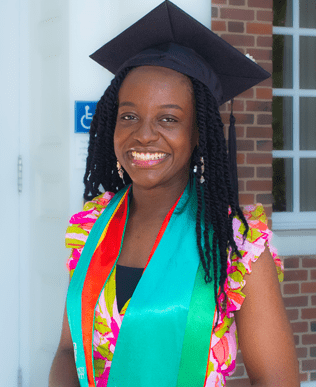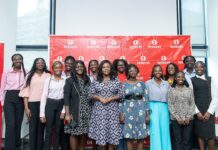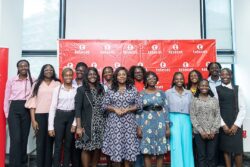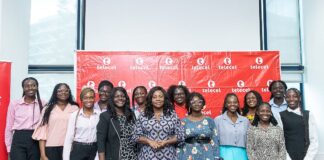By Tamisha Dzifa SEGBEFIA
When I made the decision to study engineering four years ago, I did not realize I was stepping into a space where African women were outnumbered. And yet, while less than 30% of STEM graduates in Africa are women, my experience at Ashesi was different.
I saw female lecturers like Rose Dodd, who leads the Education Collaborative to impact over 1.1 million students through ethics and entrepreneurship; and alums like Regina Honu of Soronko Academy, who is paving the way for young African women breaking into tech. Through their stories, I learned the spirit of innovation and resilience. My Ashesi lecturers didn’t just teach equations—they showed me a seat at the table. Here’s how others can do the same.
Mentorship for African women in STEM
“Mentoring is a brain to pick, an ear to listen, and a push in the right direction.” – John Crosby
We become what we see and whom we learn from. At Ashesi, I quickly realized that mentorship isn’t just about advice, it’s about transforming possibilities into realities. The more we see role models overcome challenges, the more we believe we can do the same. Mentorship guides us in making informed decisions and helps us grow in ways we never thought possible.
Across the continent, programs like Empowering Female Minds in STEM (EFeMS) and Career Hub for African Women in STEM (CAWSTEM) are shining examples, offering networks that turn mentorship into tangible opportunities.
On a personal level, serving as the Academic Committee chairperson at Ashesi placed me directly under the mentorship of our provost, Prof. Angela Owusu Ansah. From her, I learned not just the importance of dedication and excellence in academia, but also the power of paving the way for others. These lessons are ones I carry with me as I prepare for my own PhD journey, reminding me every day that mentorship is the push in the right direction.
Corporate and institutional partnerships to further support African women in STEM
Partnerships are key to creating lasting impact. Beyond individual mentorship, strong collaborations with universities, governments, and corporations create an ecosystem where African women in STEM can thrive.
These partnerships open up essential resources, expertise, and opportunities that help bridge the gap between potential and success. African universities and governments have a pivotal role to play here. By forging strategic alliances with industry leaders, they can create comprehensive support systems that go beyond classroom learning.
These collaborations provide hands-on experience, research opportunities, and real-world challenges that prepare students for the rapidly evolving STEM landscape. When institutions work together, they set the stage for a future where mentorship is scaled, opportunities are abundant, and every aspiring woman in STEM has the chance to rise to her full potential.
Creating supportive environments
Creating supportive environments isn’t just a nice-to-have, it’s a critical component of success for African women in STEM. But how do we do that, and what does it actually look like? It starts with building communities where collaboration and connection are the norm, not the exception.
Studies have consistently shown that when women in STEM have access to a robust network, they benefit from improved access to resources, stronger mentorship, and an increased sense of belonging. This, in turn, leads to better retention rates and more dynamic career growth.
So, what does a supportive environment look like? It could be a dedicated space within universities where students and professionals regularly meet to share insights, exchange feedback, and brainstorm solutions to real-world problems.
It might be structured programs like mentorship circles or networking events that connect budding innovators with experienced leaders—people who can offer guidance, opportunities, and that much-needed push in the right direction. Institutions can further this by establishing partnerships with local and international organizations to create platforms for collaboration, such as innovation hubs, joint research projects, or even online communities that keep the conversation going.
By fostering these supportive environments, we create a ripple effect, one that not only helps individuals thrive but also strengthens the entire ecosystem. With enhanced collaboration and access to vital resources, the next generation of African women in STEM will be better equipped to lead, innovate, and transform the landscape of science and technology on the continent.
The future of STEM in Africa depends on how well we support the women shaping it. Mentorship, institutional partnerships, and truly supportive environments aren’t just nice additions—they are necessities. While progress is undeniable, it remains slow and uneven. Too many brilliant young women still lack the access, guidance, and networks they need to thrive.
It’s time to move beyond rhetoric and invest in real, tangible change. African universities must prioritize mentorship programs, governments must facilitate industry partnerships, and corporations must create more inclusive pipelines for talent. However, beyond policies and programs, we each have a role to play, whether it is mentoring a young woman, advocating for better representation, or creating spaces where the next generation can see and believe in their own potential.
I was fortunate to learn from remarkable role models who showed me that I belong in STEM. Now, I’m paying it forward. If we all commit to doing the same, we won’t just increase the number of women in STEM—we’ll transform the future of innovation in Africa.
The writer is an Ashesi Alumna with the 2021-year group










